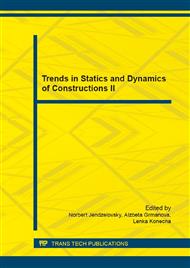[1]
R. Park, Tensile membrane behaviour of uniformly loaded rectangular reinforced concrete slabs with fully restrained edges, Magazine of Concrete Research 16(40) (1964) 39-44.
DOI: 10.1680/macr.1964.16.46.39
Google Scholar
[2]
R. Park, The ultimate strength and long-term behaviour of uniformy loaded, two-way concrete slabs with partial lateral restraint at all edges, Magazine of Concrete Research 16 (1964) 139-152.
DOI: 10.1680/macr.1964.16.48.139
Google Scholar
[3]
D. Mitchell, W.D. Cook, Preventing progressive collapse of slab structures, Journal of Structural Engineering 110(7) (1984) 1513-1532.
DOI: 10.1061/(asce)0733-9445(1984)110:7(1513)
Google Scholar
[4]
D.C. Hopkins, R. Park, Test on a reinforced concrete slab and beam floor designed with allowance for membrane action, cracking, deflection and ultimate load of concrete slab systems, ACI, SP. 30 (1971) 223-250.
DOI: 10.1680/macr.1965.17.50.29
Google Scholar
[5]
R.H. Wood, Plastic and elastic design of slabs and plates, Thames and Hudson, (1961).
Google Scholar
[6]
K. Maekawa, A. Pimanmas, H. Okamura, Nonlinear mechanics of reinforced concrete, Spon Press, (2003).
Google Scholar
[7]
M. Wieczorek, Influence of amount and arrangement of reinforcement on the mechanism of destruction of the corner part of a slab-column structure, Procedia Engineering 57 (2013) 1260–1268.
DOI: 10.1016/j.proeng.2013.04.159
Google Scholar
[8]
EUROCODE 2: Design of concrete structures - Part 1-1: General rules and rules for buildings, CEN, EN 1992-1-1, Brussels, Belgium, (2004).
Google Scholar
[9]
EN 1990: 2004/Ap1: 2004 Eurocode: Basis of structural design.
Google Scholar
[10]
CEB-FIB – Model Code 2010: Final draft, Volume 1 and 2, Bulletin 65 and 66 of the fib Model Code for Concrete Structures.
DOI: 10.1002/9783433604090
Google Scholar
[11]
CSA Standard A23. 3-04, Canadian Standard Association, (2004).
Google Scholar
[12]
SIA 262: 2003: Concrete Construction, Swiss Standards Association, Zurich, Switzerland, 2004. (in French).
Google Scholar
[13]
Concrete Construction. Introduciton, SIA 262, Excerpt from the documentation D 0182, Societe suisse des ingenieurs et des architectes, Zurich, Switzerland, 2003. (in French).
Google Scholar
[14]
EN 1991-1-7: 2008 Eurocode 1: Actions on structures, Part 1-7: General actions - Accidental actions.
Google Scholar
[15]
B. Wieczorek, Influence of the location of the column on the load capacity of a slab-column connection for the inner column after punching, Procedia Engineering 57 (2013) 1251-1259.
DOI: 10.1016/j.proeng.2013.04.158
Google Scholar
[16]
B. Wieczorek, Idea of a simplified model to determination of the load capacity of an inner slab-column connection after its punching, Procedia Engineering 65 (2013) 126-134.
DOI: 10.1016/j.proeng.2013.09.022
Google Scholar
[17]
B. Wieczorek, Experimental tests for the analysis of a load-bearing capacity of an internal slab-column connection after its punching at various positions of the column, Advanced Materials Research 969 (2014) 169-175.
DOI: 10.4028/www.scientific.net/amr.969.169
Google Scholar
[18]
EN 10002-1: 2002 Metallic materials - Tensile Testing, Part 1: Method of test at ambient temperature.
Google Scholar
[19]
EN 12390-3: 2011 Concrete tests, Part 3: The compressive strength of test samples.
Google Scholar
[20]
EN 12390-6: 2011 Testing hardened concrete, Part 6: Tensile splitting strength of test specimens.
DOI: 10.3403/30200045
Google Scholar


